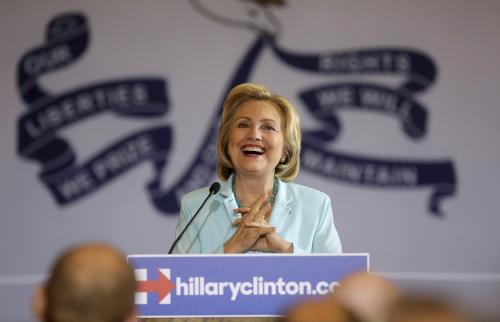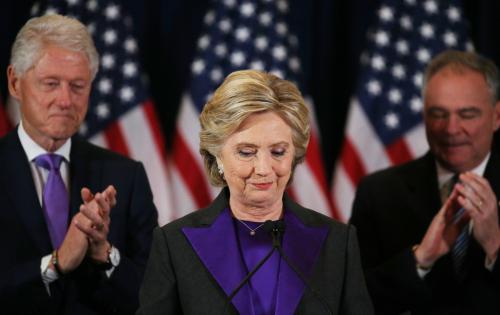Teacher unions have taken their punches in recent years. Between last summer’s Janus decision by the U.S. Supreme Court, which limited the ability of all unions to collect dues (agency fees), and new limits on collective bargaining in states like Wisconsin, it is tempting to think that union power is fading and they will have a limited impact on the 2020 Democratic primary.
Not so fast. First, as I argued in my prior post, education is playing an increasing role in daily life and especially within the Democratic party. Since teacher unions are the dominant interest group in K-12 education, this means they will have a larger role, too.
But there is much more to it than that. The growing role for education and unions may be compounded by the recent changes in Democratic National Committee rules with regard to superdelegates. It is the combination of union power and superdelegate rules that could lead to surprising teacher union power in 2020.
Some basics on the role of unions
Despite legal setbacks, the number of union members nationally has declined only slightly. The National Education Association (NEA) and American Federation of Teachers (AFT) together have more than 3 million members (who vote at high rates). In fact, there are even signs of renewed vigor in the union ranks. As the recent statewide teacher strikes suggest—including in red states like Kentucky and West Virginia—those who were previously lukewarm on unions now seem to be taking up common cause with teachers and their concerns about standardized testing and low teacher salaries.
The unions also still have two age-old tools at their disposal for political campaigns: endorsements and campaign resources. The endorsement of the unions affects not only the votes of their own members, but of all unions (11% of the workforce still belongs to a union; and 60%, despite recent backsliding, vote Democratic). Union endorsements also trigger additional campaign resources to get out the vote, which in turn signals strength to the broader electorate. Campaign rallies get noticeably larger. Big endorsements generate momentum.
But most of this doesn’t happen until late in the primary. After the unusually early backing of Hillary Clinton over Bernie Sanders in the 2016 primary, some have even argued that the teacher unions will wait until the party selects a nominee. But I’m not convinced.
The reason is that no single candidate—of the 20-plus declared so far—may come out of primary season with a clear majority of the vote, meaning that the Democratic convention in mid-July would be “contested.” If that happens, the political heft of the unions could play a decisive role. It is difficult to imagine, in a close race, that the unions would not use their power to tilt the race toward a preferred candidate, while also extracting some promises on key policy issues. Of course, it depends on who the top contenders are at that point and whether the unions have a strong preference.
One potential counterargument is that the AFT’s new endorsement process will delay and therefore diminish its power. In the wake of the 2016 primary, in which the AFT endorsed Clinton early, the union recently announced a more grassroots (and probably slower) process for selecting candidates, a nod to their members who were Bernie supporters. But, if you read the AFT’s announcement carefully, you’ll notice that the “state of the [presidential] race” will still be a factor they consider in making an endorsement. Translation: You can bet they will exert their power if the “state of the race” allows them to affect the winner.
Unions and the Democratic primary rules
The way the 2016 presidential race played out also led the DNC to change the role of the party insiders—the superdelegates—who have made up 14-20% of the total primary vote. Clinton dominated the superdelegates and Sanders’ camp contends that this turned the election in her favor. While the significance of the superdelegates in 2016 is debatable, the party changed the rules this year so that the superdelegates are not allowed until after the first ballot, to prevent the perception of an undemocratic power grab.
While this step was supposed to reduce the power of the superdelegates, it could have the opposite effect. With a contested convention, the vote would go past the first ballot and the superdelegates would regain their old power. In fact, they might be more powerful than ever. The superdelegates have arguably never been the decisive factor in the past, but it could happen in 2020 depending on how the race plays out.
Suppose, for example, that two candidates emerged, one with 35% of the vote and another with 30%, and the rest trailed with small percentages. After the first vote, no one wins. This is when the back-room deals and horse-trading would start—and when insiders thrive. If the candidate with the plurality vote is an establishment candidate (read: Joe Biden) who can peel off half the superdelegates and combine forces with one of the other mid-tier candidates, the race would be over. It is not too hard to imagine the race playing out just the way it did in 2016, with Sanders seemingly being disadvantaged by the powerful superdelegates.
Paradoxically, this shift in superdelegate power to the second ballot makes it more likely that a contested convention occurs, and therefore more likely that superdelegates will end up with this last-minute power. More broadly, it seems that shifting the timing of the superdelegate vote in the process (from first ballot to second) might not matter as much as what those pushing for it may have intended.
Back to the role of teacher unions
Let me bring this back to the role of unions, and teachers generally. About one-third of superdelegates are elected members of Congress or governors who are heavily responsible for party fundraising. Labor unions contribute $60 million annually to Democratic candidates. The remainder are DNC members who, while they might not receive funding directly, often work hand in hand with unions on campaign activities.
In a contested convention, the unions would have a powerful role even if they did hold back their endorsements until the convention. In fact, they could be more powerful because, at that point, every candidate would be desperate for their endorsement, and willing to promise more than they would early in the primary season when candidates are less inclined to make concrete promises.
It is becoming easier and easier to see how education might be pivotal in 2020. Education is becoming a key policy issue for Democrats and the unions remain the most powerful interest group connected to that issue. Changes in the AFT endorsement process and the DNC rules, while seemingly reducing their power in the primary, may not change much at all. In a very tight race, education could make or break the race.
In forthcoming blog posts from the author, the positions of leading candidates on both K-12 and higher education issues will be discussed, as well as how those positions are likely to play to voters and the unions.







Commentary
Teacher unions may be more important than ever in 2020
June 5, 2019